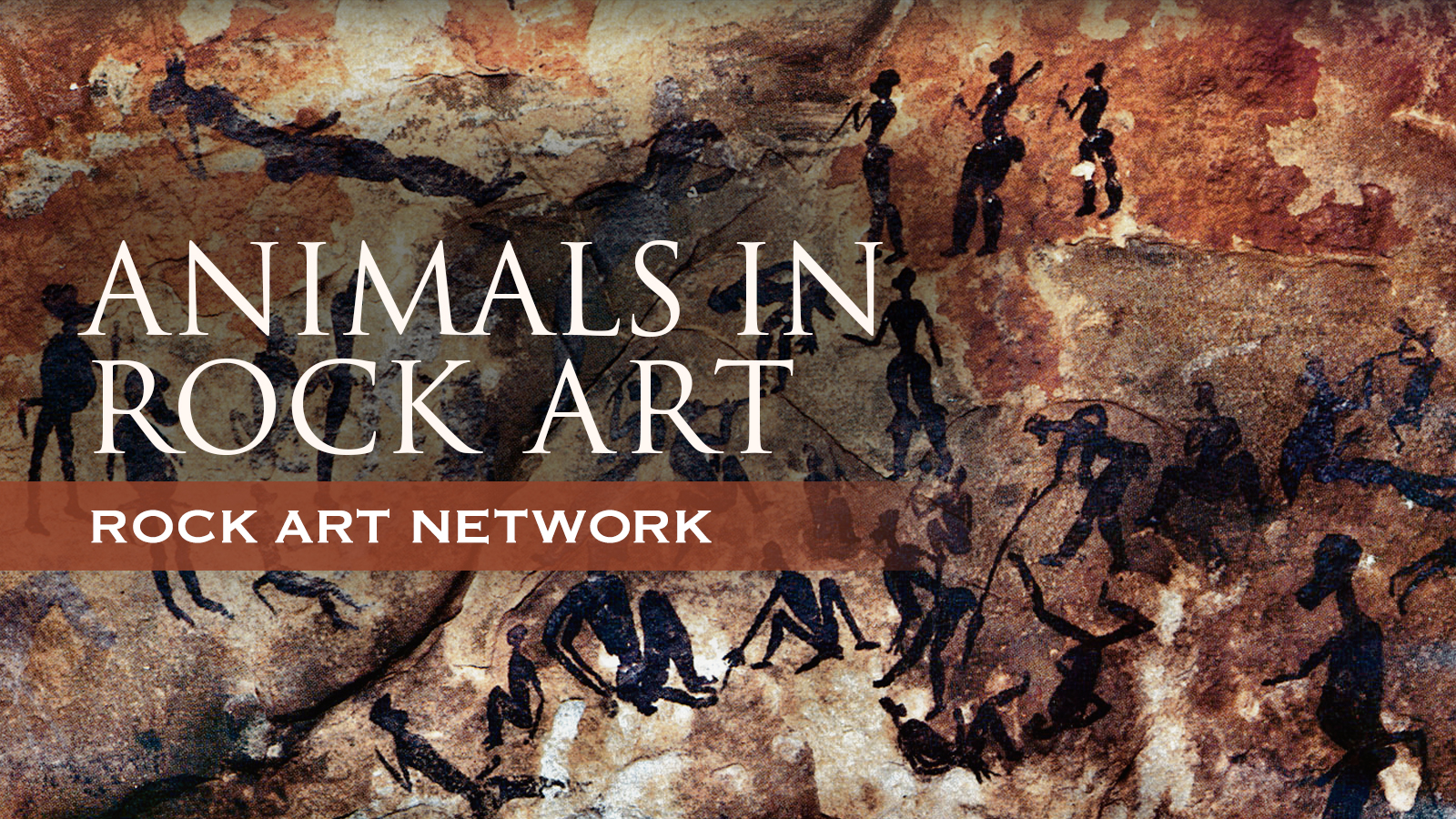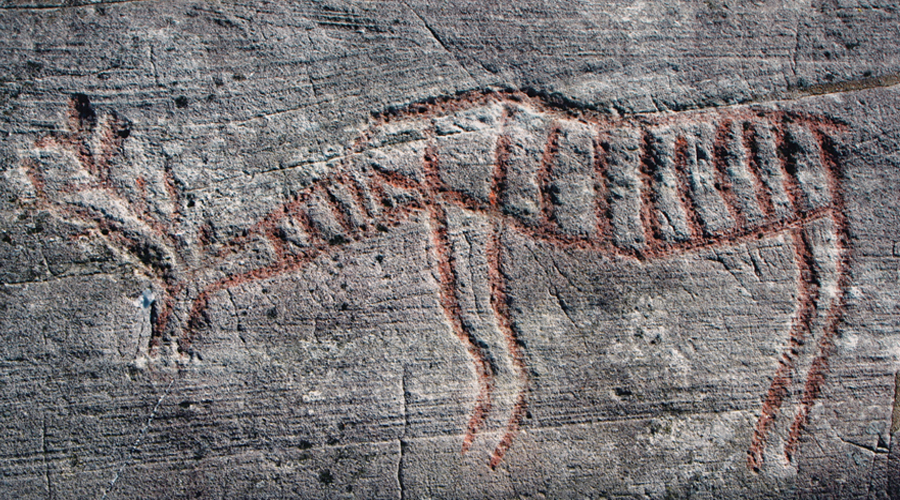


by Aron Mazel
Lecturer, Newcastle University
The 1960s to 1980s witnessed significant advances in the recording and interpretation of rock art in South Africa. The interpretative advances revolved primarily around the work of Pat Vinnicombe and David Lewis-Williams both of whom who drew on 19th and 20th century ethnographic records. In particular, Lewis-Williams demonstrated that hunter-gatherer rock art was inspired by shamanistic experiences and visions. Coupled with this, there was an upsurge in rock art recording, particularly in the uKhahlamba-Drakensberg, resulting in Pager (1971) and Vinnicombe (1976) publishing their monographs on the Didima Gorge and southern uKhahlamba-Drakensberg respectively, Lewis-Williams (1972, 1981) recording sites in the central uKhahlamba-Drakensberg, and Mazel (1981, 1984) undertaking a project to record paintings along the length of the uKhahlamba-Drakensberg.
It was in the context of these important advances in recording and interpretation that Tim Maggs and Aron Mazel, based in the Archaeology Department at the Natal Museum, as it was known at the time, were requested to produce a popular series about rock art for the African Wildlife journal, sponsored by Barclays Bank. Producing this series, in 1984 and 1985, fitted in well with the museum's aspiration to popularise knowledge about rock art and, by doing this, promote its safeguarding and conservation. Given that the series would be published in a journal dealing with wildlife, the focus was on animal imagery.
Baboons and San (Bushmen) competed for a variety of food resources; this is shown in paintings of humans fighting with and chasing baboons and the same relationship is also reflected in San folklore. A story collected from late in the last century tells how the baboons abducted and killed Cogaz the son of the San deity Kaggen.
When Kaggen discovered this he visited the baboons, while they were singing and dancing, and punished them by sending them to the mountains to live on roots, beetles and scorpions. The story concludes: "before that baboons were men, but since then they have tails and their tails hang crooked". This painting of a dancing scene clearly shows figure that are part human, part baboon.
From the Drakensberg to the Kalahari the San (Bushmen) regarded the eland as a particularly powerful symbolic influence in their religion. Eland medicine-men called upon a magic force possessed by eland to enable them to go into trance. And when in trance they saw themselves as taking on the form of an eland.
In the Western Cape it would seem that the elephant may have filled a similar role. There are paintings of part-men, part-elephant figures, while elephants enclosed by lines such as these in this painting may reflect trance vision. Scientific experiments have shown that during hallucinations people usually see concentric and zigzag patterns like these shown around the elephants.
The first herders were Stone Age people, perhaps the ancestors of the historic Khoi (Hottentots). Until about 2000 years ago all human groups that had ever lived in southern Africa survived entirely by hunting and collecting wild animals and vegetable foods.
At about this time fat-tailed sheep first appeared in southern Africa from further north. This marks the first introduction of an exotic domesticated species - hence the beginnings of food production. It appears to have taken several hundred years before cattle replaced sheep as the most important livestock species.
Rhebok are, after eland, the most common animals in the Drakensberg paintings. They are often painted in the shaded style, and the artists emphasised the graceful delicacy of these small antelope. Bones from archaeological excavations tell us that the San (Bushmen) did hunt and eat Rhebok.
However, their folklore and some of the paintings indicate that these antelope had a religious significance in addition to their food value. For example two mythical figures Haqwe and Canate were men with rhebok heads who lived mostly under water and tamed eland and snakes.
Why is the eland the preponderant animal in the rock paintings of South Africa? Many authors have argued that the Stone Age artist was motivated merely by the desire for aesthetic expression - "art for art's sake". However current research on the San (Bushmen) and their art is opening up quite a different perspective.
Many paintings seem to reflect aspects of their religious beliefs. In this context the eland has complex symbolic significance.The San (Bushmen) believe the eland is endowed with a powerful mystical force which medicine men call upon to go into trance. During trance they perform various mystical tasks such as healing, the purging of evil and rain-making. The eland as a symbol is also invoked at important ceremonies - a girl's puberty when the eland bull dance is performed, after a boy's first hunt and at marriage. To the Stone Age artists, therefore, the eland meant far more than just an animal to be hunted.
Early travellers in Natal noted that the eland migrated seasonally. They spent the summer months in the upland areas of the Drakensberg and the winter months in the lower lying midlands. Associated with these movements were differences in herd formations.
In the summer the eland came together in large mixed groups and in the winter they dispersed into smaller groups with the bulls, cows and juveniles separated from one another. Among the painted groups of eland in the Natal Drakensberg, summer scenes are the most common. This painting illustrates a typical summer scene.
We know from archaeological evidence, oral history and rock paintings that the San (Bushmen) of the Drakensberg in South Africa caught and ate fish. They used various fishing techniques - basket traps, fish-hooks and lines, spears and perhaps stone traps.
A perplexing detail in several of the painted scenes like this one from East Griqualand is the small, one-person boats or rafts from which fish are being speared. The shape of these crafts suggest that they are canoes, rather than space rafts but historically no boats are known south of Maputo, which is roughly 500 kilometres to the north-east.
Horses were first introduced into Natal in the early nineteenth century, but in large numbers only from the 1830's. The last San (Bushmen) was seen in the Natal Drakensberg, South Africa in the late 1870's.
Therefore the paintings of horses are roughly between 100 and 150 years old. Horses made a great impact on the San way of life, both in the economic and social spheres.
San became expert riders and there are many rock art paintings showing them on horesback - often hunting from horseback or leading horses and cattle, presumably after a raid, as in this rock art painting.
Any person living off the land will attest to the importance of rain. It was no different with the San (Bushmen), and it is not surprising that they strove to control the rain. Indeed, their services as rain-makers were much sought after by other communities. Dances were performed in which medicine-men entered trance. Then, with the supernatural powers that they believed were harnessed during trance, the medicine-men were thought to be able to bring rain.
Central to the procurement of rain were "rain-animals", which appear in the paintings in a variety of forms like eland, hippopotamuses or large unidentifiable spotted animals. In this painting, which is part of a larger scene, there are "rain-animals" and a dance is being performed. The "rain-animals" appear to be submerged in water and around them are people clapping and dancing. The figure above is in trance and haemorrhaging from the nose, characteristic of people in trance.
Members of the cat family are relatively rare items in the prehistoric rock painter's repertoire. Most can be identified as lions by their characteristic tails and manes. In some scenes the lion seems to be startling a group of people but we should be wary of assuming that this records an actual event.
Certain medicine-men among the San (Bushmen) believed that they could take on the form of a lion or another animal when in trance. While in this state they might go on out-of-body travel to visit neighbouring bands of San.
Therianthropes - part-human, part-animal figures - usually have some antelope (especially eland) features. One interpretation of these figures is that they are hunters disguised as animals to help them in the chase. However, the presence of such features as hooves and an articulated tail, as in this example and many others requires another explanation. The San (Bushmen) believe that the eland possesses a powerful mystical force which the medicine-man draws uopn to enable him to enter a trance.
In this altered state of consciousness he may take on the form of an eland and he performs mystical tasks important to the harmony of the whole band of people. In this and other examples the proximity between therianthropes and eland supports the trance-vision explanation.
This rock art site is one of many that has suffered from vandalism in recent times. The legislation to protect all archaeological sites in South Africa can only be effective with public support and education.
Lewis-Williams, J.D. 1972. The Syntax and Function of the Giant's Castle Rock-Paintings. South African Archaeological Bulletin. 27 (105/106), 49-65.
Lewis-Williams, J.D. 1981. Believing and Seeing: Symbolic Meanings in Southern San Rock Paintings. London: Academic Press.
Mazel, A.D. 1981 Up and down the Little Berg: archaeological resource management in the Natal Drakensberg. Final Project Report to the Department of Water Affairs, Forestry and Environmental Conservation Sub-project code 23/1/2-1/3/10/03/02.
Mazel, A.D. 1984. Archaeological survey of the Natal Drakensberg, Natal, South Africa. Journal of Field Archaeology 11, 345-356.
Pager, H. 1971. Ndedema: a documentation of the rock paintings of the Ndedema Gorge. Graz: Akademische Druck.
Vinnicombe, P. 1976. People of the Eland. Pietermaritzburg: University of Natal Press.
→ Aron Mazel is with the Newcastle University, United Kingdom, and the University of the Witwatersrand, South Africa. aron.mazel@ncl.ac.uk
→ Reflecting Back: 40 Years Since ‘A Survey of the Rock Art in the Natal Drakensberg’ Project (1978-1981)
→ San rock art exhibition at the National Museum & Research Center of Altamira
→ Discover more about the Rock Art of South Africa
→ Discover more about the Rock Art of Africa
→ Members and affiliated institutions of the Rock Art Network
by
George Nash
5/09/2024 Recent Articles
→ Sigubudu: Paintings of people with guns in the northern uKhahlamba-Drakensberg
by Aron Mazel
22/07/2024
by Richard Kuba
13/06/2024
by Meenakshi Dubey-Pathak
8/03/2024
by Rock Art Network
6/02/2024
by Rock Art Network
14/12/2023
by Sam Challis
5/12/2023
by Aron Mazel
30/11/2023
by Sam Challis
21/11/2023
by Sam Challis
15/11/2023
by Sam Challis
10/11/2023
by Rock Art Network
6/11/2023
by Rock Art Network
3/11/2023
by Aron Mazel
2/11/2023
by Meenakshi Dubey-Pathak
26/09/2023
by Paul Taçon
24/08/2023
by Aron Mazel
13/06/2023
by Paul Taçon
5/06/2023
by Paul Taçon
15/03/2023
by George Nash
14/03/2023
by Noel Hidalgo Tan
10/02/2023
by George Nash
01/02/2023
by Meenakshi Dubey-Pathak, Pilar Fatás Monforte
29/11/2022
by Aron Mazel, George Nash
21/09/2022
by Paul S.C. Taçon, Sally K. May, Ursula K. Frederick, Jo McDonald
07/07/2022
by Meenakshi Dubey-Pathak
26/07/2022
by Paul Taçon
20/07/2022
by David Coulson
16 June 2022
by Paul Taçon
25 April 2022
by Noel Hidalgo Tan
20 April 2022
by Meenakshi Dubey-Pathak
14 March 2022
by Carolyn Boyd & Pilar Fatás
02 March 2022
by David Coulson
07 February 2022
by Johannes H. N. Loubser
06 February 2022
by Meenakshi Dubey-Pathak
05 February 2022
by Aron Mazel
28 January 2022
by Aron Mazel
8 September 2021
by David Coulson
17 August 2021
by Ffion Reynolds
21 June 2021


by Aron Mazel
22/07/2024
by Richard Kuba
13/06/2024
by Meenakshi Dubey-Pathak
8/03/2024
by Rock Art Network
6/02/2024
by Rock Art Network
14/12/2023
by Sam Challis
5/12/2023
by Aron Mazel
30/11/2023
by Sam Challis
21/11/2023
by Sam Challis
15/11/2023
by Sam Challis
10/11/2023
by Rock Art Network
6/11/2023
by Rock Art Network
3/11/2023
by Aron Mazel
2/11/2023
by Meenakshi Dubey-Pathak
26/09/2023
by Paul Taçon
24/08/2023
by Aron Mazel
13/06/2023
by Paul Taçon
5/06/2023
by Paul Taçon
15/03/2023
by George Nash
14/03/2023
by Noel Hidalgo Tan
10/02/2023
by George Nash
01/02/2023
by Meenakshi Dubey-Pathak, Pilar Fatás Monforte
29/11/2022
by Aron Mazel, George Nash
21/09/2022
by Paul S.C. Taçon, Sally K. May, Ursula K. Frederick, Jo McDonald
07/07/2022
by Meenakshi Dubey-Pathak
26/07/2022
by Paul Taçon
20/07/2022
by David Coulson
16 June 2022
by Paul Taçon
25 April 2022
by Noel Hidalgo Tan
20 April 2022
by Meenakshi Dubey-Pathak
14 March 2022
by Carolyn Boyd & Pilar Fatás
02 March 2022
by David Coulson
07 February 2022
by Johannes H. N. Loubser
06 February 2022
by Meenakshi Dubey-Pathak
05 February 2022
by Aron Mazel
28 January 2022
by Aron Mazel
8 September 2021
by David Coulson
17 August 2021
by Ffion Reynolds
21 June 2021
Friend of the Foundation


by Aron Mazel
22/07/2024
by Richard Kuba
13/06/2024
by Meenakshi Dubey-Pathak
8/03/2024
by Rock Art Network
6/02/2024
by Rock Art Network
14/12/2023
by Sam Challis
5/12/2023
by Aron Mazel
30/11/2023
by Sam Challis
21/11/2023
by Sam Challis
15/11/2023
by Sam Challis
10/11/2023
by Rock Art Network
6/11/2023
by Rock Art Network
3/11/2023
by Aron Mazel
2/11/2023
by Meenakshi Dubey-Pathak
26/09/2023
by Paul Taçon
24/08/2023
by Aron Mazel
13/06/2023
by Paul Taçon
5/06/2023
by Paul Taçon
15/03/2023
by George Nash
14/03/2023
by Noel Hidalgo Tan
10/02/2023
by George Nash
01/02/2023
by Meenakshi Dubey-Pathak, Pilar Fatás Monforte
29/11/2022
by Aron Mazel, George Nash
21/09/2022
by Paul S.C. Taçon, Sally K. May, Ursula K. Frederick, Jo McDonald
07/07/2022
by Meenakshi Dubey-Pathak
26/07/2022
by Paul Taçon
20/07/2022
by David Coulson
16 June 2022
by Paul Taçon
25 April 2022
by Noel Hidalgo Tan
20 April 2022
by Meenakshi Dubey-Pathak
14 March 2022
by Carolyn Boyd & Pilar Fatás
02 March 2022
by David Coulson
07 February 2022
by Johannes H. N. Loubser
06 February 2022
by Meenakshi Dubey-Pathak
05 February 2022
by Aron Mazel
28 January 2022
by Aron Mazel
8 September 2021
by David Coulson
17 August 2021
by Ffion Reynolds
21 June 2021
Friend of the Foundation


























